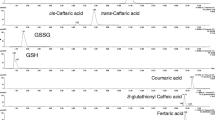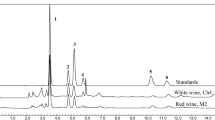Abstract
Alimentary methionine is believed to be the main source for plasma homocysteine. Recent literature supplies information about homocysteine content in daily food components, but not in wine, an attractive complement of the evening meal in some western countries. In this communication, a simple and fast high-performance liquid chromatography method for determination of total homocysteine in wine is described. The two steps procedure relies on reduction of the disulfide forms of homocysteine with tris-(2-carboxyethyl)phosphine and on-column derivatization with o-phthaldialdehyde followed by separation and fluorescence detection. The entire analysis time, including sample work-up, amounts 14 min. The calibration performed with wine matrix, spiked with homocystine within the practical concentration range, proved linear response of the detector. The proposed method was applied for the analysis of 32 different types of wines for total homocysteine. The average concentration of the analyte was 10.31 (±4.25) µM and 6.11 (±3.44) µM for red (n = 23) and white (n = 9) wines, respectively.



Similar content being viewed by others
Abbreviations
- Hcy:
-
Homocysteine.
- tHcy:
-
Total homocysteine
- (Hcy)2 :
-
Homocystine
- TCEP:
-
tris-(2-Carboxyethyl)phosphine
- OPA:
-
o-Phthaldialdehyde
- LOQ:
-
Limit of quantitation
- LOD:
-
Limit of detection
- RSD:
-
Relative standard deviation
References
Ayaori M, Hisada T, Yoshida H, Shige H, Ito T, Nakajima K, Higashi K, Yonemura A, Ishikawa T, Ohsuzu F, Saionji K, Tamai S, Nakamura H (2000) Effect of alcohol intake on the levels of plasma homocysteine in healthy males. J Nutr Sci Vitaminol 46:171–174
Bald E, Głowacki R (2005) Analysis of saliva for glutathione and metabolically related thiols by liquid chromatography with ultraviolet detection. Amino Acids 28:431–433
Bleich S, Bleich K, Kropp S, Bittermann HJ, Degner D, Sperling W, Ruther E, Kornhuber J (2001) Moderate alcohol consumption in social drinkers raises plasma homocysteine levels: a contradiction to the ‘French Paradox’? Alcohol 36:189–192
Burger M, Mensink G, Bronstrup A, Thierfelder W, Pietrzik K (2004) Alcohol consumption and its relation to cardiovascular risk factors in Germany. Eur J Clin Nutr 58:605–614
De Bree A, Verschuren WMM, Blom HJ, Kromhout D (2001) Lifestyle factors and plasma homocysteine concentrations in a general population sample. Am J Epidemiol 154:150–154
Demirkol O, Adams C, Ercal N (2004) Biologically important thiols in various vegetables and fruits. J Agric Food Chem 52:8151–8154
Ducros V, Demuth K, Sauvant MP, Quillard M, Caussé E, Candito M, Read MH, Gerhardt MF (2002) Methods for homocysteine analysis and biological relevance of the results. J Chromatogr B 781:207–226
Eikelboom JW, Lonn E, Genest J, Hankey G, Yusuf S (1999) Homocyst(e)ine and cardiovascular disease: a critical review of the epidemiologic evidence. Ann Intern Med 131:363–375
FDA Guidance for Industry Bioanalytical Method Validation (2001) http://www.fda.gov/cder/guidance/4252fnl.pdf
Fonseca V, Guba SC, Fink LM (1999) Hyperhomocysteinemia and the endocrine system: implications for atherosclerosis and thrombosis. Endocrinol Rev 20:738–759
Głowacki R, Borowczyk K, Bald E, Jakubowski H (2010a) On-column derivatization with o-phthaldialdehyde for fast determination of homocysteine in human urine. Anal Bioanal Chem. doi:10.1007/s00216-010-3456-7 (in press)
Głowacki R, Bald E, Jakubowski H (2010b) An on-column derivatization method for the determination of homocysteine-thiolactone and protein N-linked homocysteine. Amino Acids (in press)
Husemoen LLN, Linneberg A, Fenger M, Thuesen BH, Jørgensen T (2009) Changes in lifestyle, biological risk factors and total homocysteine in relation to MTHFR C677T genotype: a 5-year follow-up study. Eur J Clin Nutr 63:1233–1240
Jacobsen DW (1993) Cardiovascular disorders (risk assessment). Anal Chem 65:367–373
Jacques PF, Bostom AG, Wilson PWF, Rich S, Rosenberg IH, Selhub J (2001) Determinants of plasma total homocysteine concentration in the Framingham offspring cohort. Am J Clin Nutr 73:613–621
Pexa A, Fisher K, Deussen A, Henke T (2008) Homocysteine in food. Eur Food Res Technol 226:933–935
Rajdl D, Racek J, Trefil L, Siala K (2007) Effect of white wine consumption on oxidative stress markers and homocysteine levels. Physiol Res 56:203–212
Refsum H, Ueland PM, Nygard O, Vollet SE (1998) Homocysteine and cardiovascular disease. Ann Rev Med 49:31–62
Sakamoto A, Nishimura Y, Ono H, Sakura N (2002) Betaine and homocysteine concentrations in foods. Pediatr Int 44:409–413
Sakuta H, Suzuki T (2005) Alcohol consumption and plasma homocysteine. Alcohol 37:73–77
Ubbink JB, Fehily AM, Pickering J, Elwood PC, Vermaak HWJ (1998) Homocysteine and ischaemic heart disease in the Caerphilly cohort. Atherosclerosis 140:349–356
Acknowledgments
The authors are grateful to University of Łódź for the financial support of this research.
Author information
Authors and Affiliations
Corresponding author
Rights and permissions
About this article
Cite this article
Głowacki, R., Borowczyk, K. & Bald, E. Fast analysis of wine for total homocysteine content by high-performance liquid chromatography. Amino Acids 42, 247–251 (2012). https://doi.org/10.1007/s00726-010-0509-3
Received:
Accepted:
Published:
Issue Date:
DOI: https://doi.org/10.1007/s00726-010-0509-3




